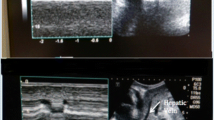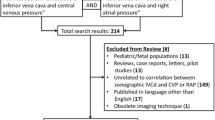Abstract
Objective
To determine the normative data for inferior vena cava (IVC) diameter in children and its correlation with various somatic parameters like height, weight and body surface area in Indian children. Readily available baseline data of IVC diameter in normal children shall be of great help in rapid assessment of variations in sick children.
Methods
Total 475 healthy children aged one month to 12 y visiting out patient clinics (OPD’s) were enrolled in this study. Weight, height and body surface area were calculated at the time of examination. The maximum and minimum diameters of IVC were measured during the expiratory and inspiratory phase of the respiratory cycle respectively using M mode ultrasonography. Collapsibility Index was also calculated for each subject by measuring difference between the maximum (expiratory) and minimum (inspiratory) IVC diameters divided by the maximum diameter.
Results
The mean age of study subjects was 4.72 ± 3.72 y. Out of 475 subjects, 285 (60%) were boys and 190 (40%) were girls. Mean weight for age (%) of subjects was 89.18 ± 13.26%. Correlation was studied between physical parameters and IVC diameter which revealed a positive correlation of age, height and weight with both maximum and minimum IVC diameter. Regression analysis was also performed to derive the equations for maximum and minimum diameters of children from 1 y to 12 y.
Conclusions
This study provides reference values of IVC diameters for Indian children of different age groups.


Similar content being viewed by others
References
Ayvazyan S, Dickman E, Likourezos A, Wu S, Hannan H. Ultrasound of the inferior vena cava can assess volume status in pediatric patients. J Emerg Med. 2009;37:219.
Ginghina C, Beladan CC, Iancu M, Calin A, Popescu BA. Respiratory maneuvers in echocardiography: a review of clinical applications. Cardiovasc Ultrasound. 2009;7:42.
Yanagawa Y, Sakamoto T, Okada Y. Hypovolemic shock evaluated by sonographic measurement of the inferior vena cava during resuscitation in trauma patients. J Trauma. 2007;63:1245–8.
Natori H, Tamaki S, Kira S. Ultrasonographic evaluation of ventilatory effect on inferior vena caval configuration. Am Rev Respir Dis. 1979;120:421–7.
Hangiandreou N. AAPM/RSNA physics tutorial for residents: topics in US. B-mode US: basic concepts and new technology. Radiographics. 2003;23:1019–33.
Wiwatworapan W, Ratanajaratroj N, Sookananchai B. Correlation between inferior vena cava diameter and central venous pressure in critically ill patients. J Med Assoc Thail. 2012;95:320–4.
Haines EJ, Chiricolo GC, Aralica K, et al. Derivation of a pediatric growth curve for inferior vena caval diameter in healthy pediatric patients: brief report of initial curve development. Crit Ultrasound J. 2012;4:12.
Kutty S, Li L, Hasan R, Peng Q, Rangamani S, Danford DA. Systemic venous diameters, collapsibility indices, and right atrial measurements in normal pediatric subjects. J Am Soc Echocardiogr. 2014;27:155–62.
Masugata H, Senda S, Okuyama H, Himoto T. Age-related decrease in inferior vena cava diameter measured with echocardiography. Tohoku J Exp Med. 2010;222:141–7.
Seif D, Mailhot T, Perera P, Mandavia D. Caval sonography in shock, a noninvasive method for evaluating intravascular volume in critically ill patients. J Ultrasound Med. 2012;31:1885–90.
Muller L, Bobbia X, Toumi M, et al. Respiratory variations of inferior vena cava diameter to predict fluid responsiveness in spontaneously breathing patients with acute circulatory failure: need for a cautious use. Crit Care. 2012;16:R188.
Chen L, Kim Y, Santucci KA. Use of ultrasound measurement of the inferior vena cava diameter as an objective tool in the assessment of children with clinical dehydration. Acad Emerg Med. 2007;14:841–5.
Levine AC, Shah SP, Umulisa I, et al. Ultrasound assessment of severe dehydration in children with diarrhea and vomiting. Acad Emerg Med. 2010;17:1035–41.
Zengin S, Al B, Genc S, et al. Role of inferior vena cava and right ventricular diameter in assessment of volume status: a comparative study: ultrasound and hypovolemia. Am J Emerg Med. 2013;31:763–7.
Author information
Authors and Affiliations
Corresponding author
Ethics declarations
Conflict of Interest
None.
Source of Funding
None.
Electronic supplementary material
Table S1
(DOCX 31 kb)
Rights and permissions
About this article
Cite this article
Taneja, K., Kumar, V., Anand, R. et al. Normative Data for IVC Diameter and its Correlation with the Somatic Parameters in Healthy Indian Children. Indian J Pediatr 85, 108–112 (2018). https://doi.org/10.1007/s12098-017-2440-z
Received:
Accepted:
Published:
Issue Date:
DOI: https://doi.org/10.1007/s12098-017-2440-z




